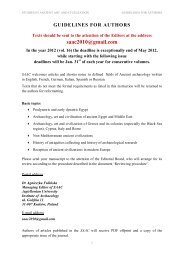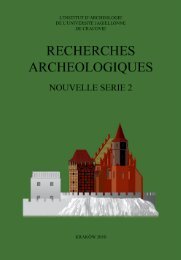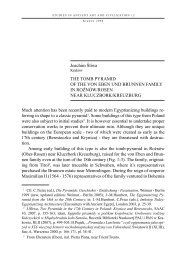l'institut d'archeologie de l'universite jagellonne de cracovie ...
l'institut d'archeologie de l'universite jagellonne de cracovie ...
l'institut d'archeologie de l'universite jagellonne de cracovie ...
You also want an ePaper? Increase the reach of your titles
YUMPU automatically turns print PDFs into web optimized ePapers that Google loves.
Excavations of the Western Kom at Tell el-Farkha in 2006<br />
the back of the head, too. Genitals are plastically<br />
mo<strong>de</strong>led, the buttock line is also clearly<br />
stressed. Knees are drawn up and outwards,<br />
while feet with plastically mo<strong>de</strong>led toes are<br />
put together. The left arm is bent in elbow<br />
and its hand with disproportionately long<br />
and thin fingers lays on the knee. The right<br />
elbow is leaned against the right knee, the<br />
hand on the mouth level. Three fingers are<br />
together, the thumb or the in<strong>de</strong>x finger (partially<br />
preserved) was touching the mouth.<br />
Hippopotamus tusk. Height 5.2 cm. Inv. no.<br />
WD06/40 (R-639).<br />
F. Animals<br />
1. Animal head (crocodile ?). Probably<br />
an amulet. Strongly marked ears<br />
and jaws. Light-green faience. Measurements<br />
3.5×1.5×2.0 cm. Inv. no. WD/06/10<br />
(R-609).<br />
2. Fish – tilapia (Fig. 21). Fins covered with<br />
incisions, its snout marked with a curling.<br />
Eyes are round with pupils represented by a<br />
dot. An elliptic hole in the basis (0.7×0.3 cm)<br />
1.1 cm <strong>de</strong>ep. Hippopotamus tusk. Measurements<br />
2.9×5.0×0.9 cm. Inv. no. WD/06/20<br />
(R-619).<br />
3. Animal. Lion or dog. The figurine is<br />
pierced crosswise through the trunk. The<br />
animal is presented in a lying position, with<br />
its paws drawn fore. Mo<strong>de</strong>ling is very schematic.<br />
At the back of the body there is the<br />
tail marked. Numerous cracks on the surface,<br />
which show a white substance covered<br />
with a grey one, placed on the top of it.<br />
The figurine is ma<strong>de</strong> of slightly baked silt,<br />
presumably on a faience or limestone core.<br />
Measurements 2.8×4.3×1.5 cm. Inv. no.<br />
WD/06/24 (R-623).<br />
4. Animal. Lion or dog. A representation of<br />
an animal lying on its fore paws tucked un<strong>de</strong>rneath.<br />
The exact specie of the animal is<br />
difficult to <strong>de</strong>fine. The head is schematically<br />
mo<strong>de</strong>led with an elongated, roun<strong>de</strong>d muzzle,<br />
almond-shaped eyes and almost round<br />
435<br />
ears. At the back of the figure a distinctive<br />
short and thick tail. The back slightly bent<br />
in its fore part, paws with visibly marked<br />
claws. The surface is effaced, what makes<br />
interpretation difficult. The shape of head<br />
and ears in particular may suggest a lion.<br />
Bad state of preservation: numerous horizontal<br />
and vertical <strong>de</strong>laminations, many<br />
losses on the surface. Hippopotamus tusk.<br />
Measurements 3.2×6.5×2.1 cm. Inv. no.<br />
WD06/57 (R-656).<br />
5. Dog (Fig. 22). A lying animal with its<br />
paws drawn forward and put paralelly. A<br />
plastically mo<strong>de</strong>led muzzle, eyes marked<br />
with a curving. The left ear is damaged and<br />
from the tail only its base is preserved. A<br />
hole in the bottom 0.5 cm in diameter and<br />
0.8 cm <strong>de</strong>ep. Numerous cracks. Hippopotamus<br />
tusk. Measurements 2.2×4.5×1.3 cm.<br />
Inv. no. WD06/44 (R-643).<br />
6. Uraeus. A figure of a rearing cobra. Plastically<br />
mo<strong>de</strong>led head. Round eyes marked<br />
with a curving. A hole in the place of jaws<br />
0.3 cm in diameter 1 cm <strong>de</strong>ep. Most certainly<br />
the snake’s tongue of some different<br />
material was fixed in it. Plastically mo<strong>de</strong>led<br />
back and hood. A hole 0.5 cm in diameter<br />
and 1.1 cm <strong>de</strong>ep placed at the back<br />
in the figure’s lower part. Good state of<br />
preservation, a small loss in the left part of<br />
the hood and by the lower hole. Hippopotamus<br />
tusk. Height 6.1 cm. Inv. no. WD/06/29<br />
(R-628).<br />
7. Uraeus. A figure of a rearing cobra. Plastically<br />
mo<strong>de</strong>led head. Round eyes marked<br />
with a curving. A hole in the place of jaws<br />
0.3 cm in diameter 1 cm <strong>de</strong>ep. Most certainly<br />
the snake’s tongue of some different<br />
material was fixed in it. Plastically mo<strong>de</strong>led<br />
back and hood. A hole 0.6 cm in diameter<br />
and 1.5 cm <strong>de</strong>ep placed at the back in the<br />
figure’s lower part. Numerous cracks, some<br />
lacks of the left part of the hood, losses by<br />
the lower hole. Hippopotamus tusk. Height<br />
6.1 cm. Inv. no. WD/06/30 (R-629).





